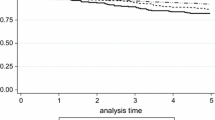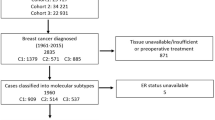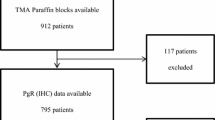Summary
In oestrogen receptor-positive (ER+) breast cancer, HER-2/neu and the progesterone receptor (PR) are inversely associated. This explains a lower response to anti-oestrogens if ER+ breast cancers are HER-2/neu positive. One randomized study however, showed that premenopausal women with an ER+ breast cancer respond to anti-oestrogens independent of HER-2/neu. We therefore hypothesized an age-related association between HER-2/neu and PR in ER+ breast cancers. Receptors for ER, PR and HER-2/neu were analysed by immunohistochemistry (IHC). A uni- and multivariate analyses was carried out to assess this relationship in 1104 women with an ER+ breast cancer. We observed an inverse association between HER-2/neu and PR only after age 45. There were 173 women of age ≤45 and 931 of age >45 years. In multivariate analysis, only tumour grade (p=0.005) but not PR status was associated with HER-2/neu in women age ≤45 years. However, in age >45 years group, both PR status (p=0.001) and tumour grade (p = 0.001) were independently associated with HER-2/neu. In ER+ breast cancers from women age >45, PR was positive in 76.9% if HER-2/neu negative but in 53.4% if HER-2/neu positive (p<0.001) and the median quantitative PR levels are 150 and 75 respectively in HER-2/neu negative and HER-2/neu positive tumours (p=0.002). This age effect of HER-2/neu on the PR status was not seen in women age ≤45 years and the median quantitative PR levels are 200 and 220 respectively in HER-2/neu negative and HER-2/neu positive tumours (p = 0.518). The study confirms an age-related inverse relationship between HER-2/neu and PR only in women age >45 years but not in women age ≤45 years.
Similar content being viewed by others
References
KB Hortowitz WL McGuire (1975) ArticleTitlePredicting response to endocrine therapy in human breast cancer: a hypothesis Science 189 726–727 Occurrence Handle168640
KS Russell MC Hung (1992) ArticleTitleTranscriptional repression of the neu protooncogene by estrogen stimulated estrogen receptor Cancer Res 52 6624–6629 Occurrence Handle1:CAS:528:DyaK3sXjtlWguw%3D%3D Occurrence Handle1358436
D Lüftner A Jung P Schmid R Geppert E Kienle KD Wernecke K Possinger (2003) ArticleTitleUpregulation of HER-2/neu by ovarian ablation: results of a randomized trial comparing leuprorelin to CMF as adjuvant therapy in node-positive breast cancer patients Breast Cancer Res Treat 80 245–255 Occurrence Handle10.1023/A:1024911625339 Occurrence Handle14503797
R Zeillinger F Kury K Czerwenka E Kubista G Sliutz W Knogler J Huber C Zielinski G Reiner R Jakesz (1989) ArticleTitleHER-2 amplification, steroid receptors and epidermal growth factor receptor in primary breast cancer Oncogene 4 109–114 Occurrence Handle1:CAS:528:DyaK3cXmtV2is7s%3D Occurrence Handle2915900
G Konecny G Pauletti M Pegram M Untch S Dandekar Z Aguilar C Wilson HM Rong I Bauerfeind M Felber HJ Wang M Beryt R Seshadri H Hepp DJ Slamon (2003) ArticleTitleQuantitative association between HER-2/neu and steroid hormone receptors in hormone receptor-positive primary breast cancer J Natl Cancer Inst 95 142–153 Occurrence Handle1:CAS:528:DC%2BD3sXovFelug%3D%3D Occurrence Handle12529347
S Taucher M Rudas RM Mader M Gnant P Dubsky T Bachleitner S Roka F Fitzal D Kandioler E Sporn J Friedl M Mittlbock R Jakesz (2003) ArticleTitleDo we need HER-2/neu testing for all patients with primary breast carcinoma? Cancer 98 2547–2553 Occurrence Handle10.1002/cncr.11828 Occurrence Handle1:CAS:528:DC%2BD2cXit1yhsA%3D%3D Occurrence Handle14669272
PM Ravdin S Green TM Dorr WL McGuire C Fabian RP Pugh RD Carter SE Rivkin JR Borst RJ Belt (1992) ArticleTitlePrognostic significance of progesterone receptor levels in estrogen receptor-positive patients with metastatic breast cancer treated with tamoxifen: results of a prospective Southwest Oncology Group study J Clin Oncol 10 1284–1291 Occurrence Handle1:STN:280:DyaK38zktFWntg%3D%3D Occurrence Handle1634918
M Ferno O Stal B Baldetorp T Hatschek AC Kallstrom P Malmstrom B Nordenskjold S Ryden (2000) ArticleTitleResults of two or five years of adjuvant tamoxifen correlated to steroid receptor and S-phase levels: South Sweden Breast Cancer Group, and South-East Sweden Breast Cancer Group Breast Cancer Res Treat 59 69–76 Occurrence Handle10.1023/A:1006332423620 Occurrence Handle1:CAS:528:DC%2BD3cXis1yjsb0%3D Occurrence Handle10752681
VJ Bardou G Arpino RM Elledge CK Osborne GM Clark (2003) ArticleTitleProgesterone receptor status significantly improves outcome prediction over estrogen receptor status alone for adjuvant endocrine therapy in two large breast cancer databases J Clin Oncol 21 1973–1979 Occurrence Handle10.1200/JCO.2003.09.099 Occurrence Handle1:CAS:528:DC%2BD2cXptlCksbg%3D Occurrence Handle12743151
PL Fitzgibbons DL Page D Weaver AD Thor DC Allred GM Clark SG Ruby F O’Malley JF Simpson JL Connolly DF Hayes SB Edge A Lichter SJ Schnitt (2000) ArticleTitlePrognostic factors in breast cancer Arch Pathol Lab Med 124 966–978 Occurrence Handle1:STN:280:DC%2BD3czptVKrtQ%3D%3D Occurrence Handle10888772
Mohsin SK, Weiss H, Havighurst T, Clark GM, Berardo M, Roanh LD, To TV, Zho Q, Love RR, Allred DC: Progesterone receptor by immunohistochemistry and clinical outcome in breast cancer: a validation study. Modern Pathology advance online publication 23 July 2004: 1–10, 2004
H Yamauchi V Stearns DF Hayes (2001) ArticleTitleWhen is a tumor marker ready for prime time? A case study of c-erbB-2 as a predictive factor in breast cancer J Clin Oncol 19 2334–2356 Occurrence Handle1:CAS:528:DC%2BD3MXjsFeqsrg%3D Occurrence Handle11304787
MJ Ellis A Coop B Singh L Mauriac A Llombert-Cussac F Janicke WR Miller DB Evans M Dugan C Brady E Quebe-Fehling M Borgs (2001) ArticleTitleLetrozole is more effective neoadjuvant therapy than tamoxifen for ErbB1 and ErbB2-positive, estrogen receptor-positive primary breast cancer: evidence from a phase III randomized trial J Clin Oncol 19 3808–3816 Occurrence Handle1:CAS:528:DC%2BD3MXnsVKqsbo%3D Occurrence Handle11559718
RR Love NB Duc TC Havighurst SK Mohsin Q Zhang DL DeMets DC Allred (2003) ArticleTitleHER-2/neu overexpression and response to oophorectomy plus tamoxifen adjuvant therapy in estrogen receptor-positive premenopausal women with operable breast cancer J Clin Oncol 21 453–457 Occurrence Handle10.1200/JCO.2003.10.133 Occurrence Handle1:CAS:528:DC%2BD2cXpsVGrtLw%3D Occurrence Handle12560434
EW Elston IO Ellis (1993) ArticleTitleMethod for grading breast cancer J Clin Pathol 46 189–190 Occurrence Handle1:STN:280:DyaK3s3htVaitQ%3D%3D Occurrence Handle8459046
WF Anderson KC Chu N Chatterjee O Brawley LA Brinton (2001) ArticleTitleTumor variants by hormone receptor expression in white patients with node-negative breast cancer from the Surveillance, epidemiology and end results database J Clin Oncol 19 18–27 Occurrence Handle1:CAS:528:DC%2BD3MXot1Wgsg%3D%3D Occurrence Handle11134191
A Rhodes B Jasani AJ Balaton DM Barnes KD Miller (2000) ArticleTitleFrequency of oestrogen and progesterone receptor positivity by immunohistochemical analysis in 7016 breast carcinomas: correlation with patient age, assay sensitivity, threshold value, and mammographic screening J Clin Pathol 53 688–696 Occurrence Handle10.1136/jcp.53.9.688 Occurrence Handle1:STN:280:DC%2BD3cvptV2ksA%3D%3D Occurrence Handle11041059
DC Allred GM Clark R Molina AK Tandon SJ Schnitt KW Gilchrist CK Osborne DC Tormey WL McGuire (1992) ArticleTitleOverexpression of HER-2/neu and its relationship with other prognostic factors change during the progression of in situ to invasive breast cancer Hum Pathol 23 974–979 Occurrence Handle10.1016/0046-8177(92)90257-4 Occurrence Handle1:STN:280:DyaK38zoslOjtA%3D%3D Occurrence Handle1355464
GM Clark CK Osborne WL McGuire (1984) ArticleTitleCorrelations between estrogen receptor, progesterone receptor, and patient characteristics in human breast cancer J Clin Oncol 2 1102–1109 Occurrence Handle1:STN:280:DyaL2M%2Fjt1OrsQ%3D%3D Occurrence Handle6491696
H Yaziji LC Goldstein TS Barry R Werling H Hwang GK Ellis JR Gralow RB Livingston AM Gown (2004) ArticleTitleHER-2 testing in breast cancer using parallel tissue-based methods JAMA 291 1972–1977 Occurrence Handle10.1001/jama.291.16.1972 Occurrence Handle1:CAS:528:DC%2BD2cXjs1ajtrk%3D Occurrence Handle15113815
JS Ross JA Fletcher GP Linette J Stec E Clark M Ayers WF Symmans L Pusztai KJ Bloom (2003) ArticleTitleThe HER-2/neu gene and protein in breast cancer 2003: biomarker and target of therapy Oncologist 8 307–25 Occurrence Handle10.1634/theoncologist.8-4-307 Occurrence Handle1:CAS:528:DC%2BD3sXmvFSqt74%3D Occurrence Handle12897328
S Akli PJ Zheng AS Multani HF Wingate S Pathak N Zhang SL Tucker S Chang K Keyomarsi (2004) ArticleTitleTumor-specific low molecular weight forms of cycling E induce genomic instability and resistance to p21, p27, and antiestrogens in breast cancer Cancer Res 64 3198–208 Occurrence Handle1:CAS:528:DC%2BD2cXjs1eht7Y%3D Occurrence Handle15126360
J Shou S Massarweh CK Osborne AE Wakeling S Ali H Weiss R Schiff (2004) ArticleTitleMechanisms of tamoxifen resistance: increased estrogen receptor-HER2/neu cross-talk in ER/HER2-positive breast cancer J Natl Cancer Inst 96 926–935 Occurrence Handle1:CAS:528:DC%2BD2cXltVWmtLY%3D Occurrence Handle15199112
CK Osborne V Bardou TA Hopp GC Chamness SG Hilsenbeck SA Fuqua J Wong DC Allred GM Clark R Schiff (2003) ArticleTitleRole of the estrogen receptor coactivator AIB1 (SRC-3) and HER-2/neu in tamoxifen resistance in breast cancer J Natl Cancer Inst 95 353–361 Occurrence Handle1:CAS:528:DC%2BD3sXivVeqsrg%3D Occurrence Handle12618500 Occurrence Handle10.1093/jnci/95.5.353
Dowsett M on behalf of the ATAC Trialists’ Group. Analysis of time to recurrence in the ATAC trial according to estrogen and progesterone receptor status. Proceedings from the 26th annual San Antonio Breast Cancer Symposium (Abstract), 2003
Author information
Authors and Affiliations
Corresponding author
Rights and permissions
About this article
Cite this article
Huang, HJ., Neven, P., Drijkoningen, M. et al. Association between HER-2/neu and the progesterone receptor in oestrogen-dependent breast cancer is age-related. Breast Cancer Res Treat 91, 81–87 (2005). https://doi.org/10.1007/s10549-004-8235-8
Issue Date:
DOI: https://doi.org/10.1007/s10549-004-8235-8




